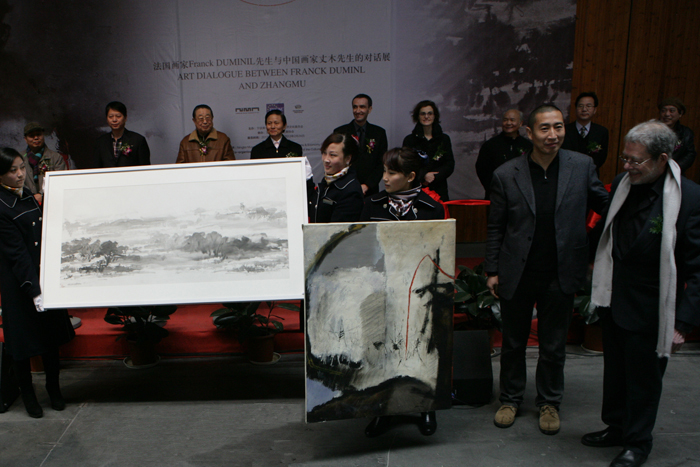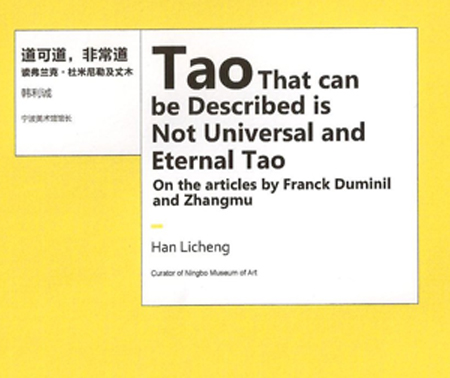
DUMINIL (catalogue de l'exposition crédit photo : Khaldoun Zreik)

Du 23 janvier au 9 avril 2013 Duminil a été invité par le Musée d'Art de Ningbo à y exposer 37 œuvres récentes. Exposition conjointe et rencontre Franco-Chinoise avec le peintre Zhangmu, manifestation intitulée :
Elle s'est poursuivie au Musée des Beaux Arts de Zhejiang (Hangzhou) et au Musée d'Art de Shaoxing.

Cette exposition se présentait en fait comme un dialogue entre les oeuvres de deux peintres contemporains, DUMINIL et ZHANGMU (peintre chinois) à l'occasion du Festival de Pintemps. Remise des œuvres à la collection du Musée - À droite Zhangmu et Duminil. (Crédit photo : Musée de Ningbo)
Vous trouverez ci-après des photographies de cet évènement ainsi que des extraits du catalogue édité à cette occasion.

Préface de M. le Conservateur du Musée de Ningbo.
(Catalogue de l'exposition)

A doctrine or a theory could be very attractive if it is simple, grand and mysterious. It is just like the words spoken by an old man in a deep voice while a group of smart people are arguing fiercely
(Yu Qiuyu, The culture of the forty-seven class - From Peking University to the National Taiwan University).
By reading their articles, I got to know the two artists - one from the west and the other from the east. Exactly as what Yu Qiuyu has suggested, the simple
works of the French artist Franck Duminil are really fascinating. What we see on the paintings are red and black, yellow and green embellished on white ot light background, and occasionally with a few geometric lines. And every background, color and line in his painting is as simple as it could be
, without complicated, gaudy and plentiful tableaus. This is in accordance with the words by Ms. Ji Zhenchen : he is just like Laozi of China. Tao that can be described is not universal and eternal Tao
is a celebrated dictum by Laozi to reveal the secret of the universe. The Dao
of nature, universe and beings cannot be described
. His painting filled with simple colors and figures that have great form but without shape, left us with wide space and time for imagination. By subtile changes of color and forms, he skillful enlarges the dimensions of pictures, so as to show the relations between human being and universe, society and nature, culture and ignorance, Yin and Yang, pros and cons. The close relations between human being and nature, and the mysteries depicted by the pictures show his great admiration and respect to nature. And all these, in the same time, make him different from most contemporary artists in the west. The painting before us are the achievements of his of his recent explorations and works of signifiance.
As un artist from the east, Zhangmu regards his ink as it was gold. While abandoning the oriental way of thinking, he does not follow the narrative methods of the west, but depicts the world by Dao
advocated by Laozi. The conceptions and scenarios presented by himm not only provide us with chances to have a better understanding of the world
that filled with pleasure, anger, sorrow and joy, but also the chances to be aware of what Laozi mean by the Dao that can be named is not the true name of the Dao
.
As the endeavors by the two artists have us a world of one dream, we would like to take this rare opportunity to invite them to hold exhibition in Ningbo Museun of Art durin Sprng Festival.
Han Licheng (Curator of Ningbo Museum of Art)
Evening of Jan. 14, 2013 in Dan Quan Zhai.

NINGBO - Cérémonie d'inauguration. De gauche à droite : Mme Zhenchen Jin, Commissaire des Expositions ; M. Anthony Chaumuzeau, Conseiller Culturel de l'Ambassade de France ; Duminil (crédit photo : Musée de Ningbo.)
Préface de S.E. Madame Sylvie BERMANN, Ambassadeur de France en Chine
(Catalogue de l'exposition)



De gauche à droite : Mme Zhang Weiping, vice-conservateur du Musée de Ningbo, Zhangmu et Duminil
À l'arrière-plan, à droite, Mme Marion Bertagna, Attaché Culturel du Consulat Général de France à Shangaï.(crédit photo : Musée de Ningbo)
Préface (extrait)de Mme Lydia Harambourg, Historienne Critique d'art
(Catalogue de l'exposition)

Frank Duminil transcrit l'univers par une gestuelle informelle animée d'une énergie qu'il partage avec son homologue chinois, le peintre Zhangmu. Le premier est abstrait sans avoir rompu avec la nature dans laquelle il nous semble reconnaître des paysages cosmiques. Son cadet issu d'une famille chinoise de lettrés revendique l'héritage d'une tradition de la peinture à l'encre de Chine Tang, Song, Yuan, Ming, Qing. Zhangmu est l'héritier de ce que les Chinois appelaient le Ch'in jun (pour désigner l'âme intime du peintre que révèle son coup de pinceau) et le shêng-toung (mouvement de la vie) qu'il applique dans des paysages rythmés comme de longs poèmes. L'un et l'autre se refusent à dépeindre le paysage qui se confond pour l'artiste chinois avec une religion du paysage destiné à la méditation. La peinture de paysage ou Chan Chouei (Monts et Eaux) suggère ses harmonies intérieures auxquelles le peintre occidental donne ses réponses avec des équivalences plastiques, des tensions, des scansions linéaires. Tous les deux manifestent le monde d'au-delà
dont parle Klee. Leur propension à la schématisation les rapproche encore dans un lyrisme radieux. Ils recourent au signe qui préside aux lois organiques de la peinture et participe à son élaboration par la matière et la couleur. Pour chacun, le signe est l'expression vécue d'un fait de nature en prenant l'apparence d'écritures lisibles et secrètes. C'est sur l'indicible de l'écrit que leurs tableaux nous offrent de méditer. (...)
Lydia Harambourg
Historienne Critique d'art, Membre correspondant de l'Institut Académie des Beaux-Arts
Janvier 2013

Remise du certificat d'entrée dans la collection du Musée. De gauche à droite : Duminil et Mme Zhenchen Jin,Commissaire des Expositions. (crédit photo : Musée de Ningbo)


Huile sur toile, détail - DUMINIL (catalogue de l'exposition)


Encre de chine sur papier - ZHANGMU (catalogue de l'exposition)


ZHANGMU (catalogue de l'exposition)








